Afroasiatik – a kung-fu hip-hop larp – recap part 3
Warning: long post ahead. Read the short version here.
Part 1: the original reason for the game, a history of French hip-hop and its Asian influences
Part 2: how inspiration sources were used to build a game world that featured kimono-wearing rappers in a European zen garden
Part 3: the performance aspect of the larp and what worked, what didn’t

The bridge to Stayzen Island, with the battle banner. Photo © Valérie Bauwens
The plot (SPOILERS)
I wanted one last hip-hop theme for the larp: competition. From graffiti writers crossing over each other, to dance contests like Juste Debout, to rap battles made famous by 8 mile, competition is an important part of hip-hop culture. It also enabled to have hip-hop performances that actually mattered for the game, and were not just here for show. I had sat through too many Toreador talent shows in US Vampire larps to impose this onto my players. So the main plot of Afroasiatik was the Battle of Year, a contest to choose the leaders of the hip-hop movement for one year, through contests of skills in the five disciplines of hip-hop. This time, exceptionally, Samurastas wouldn’t only be judges, but actual contestants. They were pissed off at Shogunatives for co-opting the resources of hip-hop for their mysterious own use after the 2012 victory (actually planting bombs in nuclear power plants across the empire). And they were pissed off at the Afrochinese for promoting commercial hip-hop (actually through a a sort of fusion between maho and vaudou zombie to achieve mind control). On the way to the Aigle zen garden where the battle was supposed to be held, all DJ contestants and one rapper, Benkei, were killed by mysterious attackers. Likely culprits in the game world were governmental Boxer or Ninja hit squads from Afrochina or Shogunato, who had also infiltrated each hip-hop group. This was to remind the participants that their culture was in danger.
The first group move of the ritual was an old-school popping wave to try to resurrect Benkei through the power of hip-hop. Photo © Valérie Bauwens
Performance
I wanted players to actually perform during the larp, even if, like me or my co-organizer, they had never done it before. I wanted them to feel hip-hop in their own bodies, not just talk about it. I turned to the Nordic scene for advice as, when it comes to performance in larp, they’ve sort of been there, done that. Yes, I also know of the US larp Lullaby of Broadway, but I’m allergic to musicals. Furthermore, many larpers in the Knutepunkt scene are performers in real life. So I asked directly for advice at KP2013 in Norway, both in my own an item presenting a short version of my goals for Afroasiatik, and by attending the perfectly timed Dare to be creative workshop by Marion Bræstrup Løsnesand & friends, about in-larp artistic performance. The advice was amazing, and revolved around: “Make it easy for people”.
To this day, we still don’t know what the poet in pink said in Japanese during his performance. Photo © Valérie Bauwens
Set the bar low
Just like people are not expected to really fight with a real two-handed axe in most fantasy larps, players weren’t really asked to rap for real (or at least not for a long time). So I had to loosen a bit my definition of hip-hop. Martial arts enabled people to still give a visual performance, without real world hip-hop expertise-. And slam poetry was allowed as an aspect of rapping. I knew several players wrote well, but could not keep in time with a beat. Finally someone could be the host/presenter/MC, which in my opinion is also a type of performance.
“Terminator X called, he wants his glasses back”. The character of the presenter Olivia Ka-Ching was actually a tribute to pioneering French hip-hop journalist Olivier Cachin. The player worked on intros for the other player’s characters during the workshops. Photo © Valérie Bauwens
Everybody must perform
One of the key thing to reduce stage fright was to know that everyone would be on stage at some point, in front of everyone else. And to make sure that even the martial artists, host and graffiti artists would do some rapping and dancing, the game would open by a hip-hop ritual to resurrect Benkei, the rapper who had just been killed. This way the group would dance together and rap a short chorus together, at the very beginning of the game. A few months before the larp, after 13 years of nearly no Asian references, IAM just made a track where the two MCs tell their autobiography using the aliases of Japanese heroic warriors, Benkei & Minamoto.
This was a sign! So I wrote two characters based on Benkei and Minamoto. They were the first trans-block hip-hop duo, which explained why they would be famous in the hip-hop world. Two players of dancer characters prepared a simple choreography for everyone. Two of the rapper players were crazy enough to agree to memorize the longer-than-expected lyrics, and off we went.
Make it easy
Both vocal and instrumental versions of the ritual song were available as mp3s for people to rehearse at home. Players were scattered across two countries and more than 800km, so there was no way to bring people together before the game week-end. The soundtrack overall included dozens of pieces by Onra, Chinese Man, Tha Trickaz etc, both as mood setting and background music for dancing or rapping over. People were allowed to do covers of other rap tracks they already knew, re-use lyrics and put them on new instrumentals, or create everything from scratch. Graffiti artists were encouraged to borrow images from the web and photoshop them onto pagodas etc. Martial artists were told they could use the combat system (see below), but the players preferred to use their actual martial arts skills to rehearse a staged fight. I lightly plotted the fight according to the characters’ motivations and they made wonders with it.
Laouenan Yojimbo combined dance and martial arts for his solo performance. Photo © Valérie Bauwens
Make people feel safe
It seems some Nordic performance larps had participants whose sole role was to applaud. I didn’t have that extreme view but wanted the same effect. Applause was guaranteed through the rules of engagement: people from your group would cheer, organizers would cheer, and Samurastas would cheer for everyone, in the spirit of Peace Unity Love and Havin’ fun. A guaranteed 2/3rd positive crowd does make things easier for stage fright.
Performance workshops
On the Saturday night before Afroasiatik, players gathered in Lausanne to get to know each other and rehearse. It was important because half came from France, from a small, experimental, Nordic-influenced larp subculture, and half were more traditional locals. Also, some people were more interested by the Asian aesthetics, others by the hip-hop aspect. Most were curious because of the weirdness of the concept and some had liked my previous larps, so wanted to try to see this one. Therefore, getting to know each other through icebreakers and rehearsing the ritual was important. It showed everyone we were friendly people, that no one would be judged and that this was going to be fun. And because everyone had been rehearsing alone, alignment was helpful to explain how the Battle of the Year would work. The excitement that night reminded me of theater classes in junior high. It confirmed that we weren’t only organizing a larp, we were organizing a show.
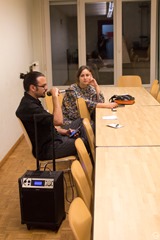
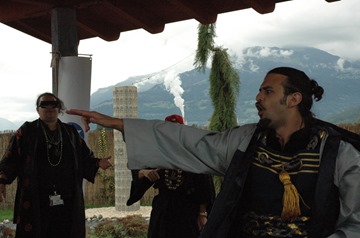
The power of workshops and rehearsals: before, after. Photo © Oliver V, left and Valérie Bauwens, right
Safety workshops
An important thing to workshop was violence. Even though there was a lot of humor and ridicule in the setting, aggression and in general intensity were not discouraged. So we introduced “cut” and “brake” to enable an easy way out of uncomfortable scenes. For those that wanted more intensity, I reused the “frakk” rule from The Monitor Celestra. I changed it to “C’est à moi qu’tu parles?”, a scene from La haine, a classic French movie where a character is channeling Robert De Niro’s “You talkin’ to me?”. The combat system was originally invented decades ago by French larpers and renamed “Scratch battle”. It used fabric strips attached to the wrists by small velcro squares. Fights were highly ritualized duels, like in Hong-Kong action movies or video games, with posing and rounds. The goal was to look good and rip the opponent’s two strips to defeat them. It was thus a game of skill rather than actual violence. The main issue was that the player demonstrating the method actually hurt his hand during the workshop, sort of dampening the perception of safety.
Martial arts masters (left) had shorter strips to make them harder to beat. Photo © Valérie Bauwens
Lead by example
Performing in a group is one thing, performing alone is another. So before the individual performances, the organizers were the opening act, warming up the crowd. We rapped a track by IAM a capella, because finding that instrumental version proved impossible. This also enabled me to say the line “it’s true that Shaolin was invaded by the Manchu/helped by traitors they entered and burned everything”, which was part of my secret agenda for the larp.
The secret hip-hop larp agenda.
Afroasiatik was first and foremost a personal obsession, merging two hobbies that never mix. For this purpose, it was a success and very selfishly satisfying. It was also a lot about nostalgic discussions. About what hip-hop was/could have been, hence the t-shirt I was wearing, the 3-level phrase “rap used to be better”. This resonated a lot with 1/4th of the players who were 30-ish and knew quite a bit about hip-hop before signing up before the game. But I also had the secret agenda of exposing average larpers to hip-hop techniques, themes and culture. Did this work? Here are some very limited stats with horribly leading questions. Better than nothing I guess.
Did you learn something about hip-hop, as a culture and/or an artistic form? (1:nothing at all, 5: a lot)
Mixed replies, but definitely some learning happened. From the free text comments, people that already knew about hip-hop didn’t really learn knew things. They went back to their 1990s classics for nostalgic fun, both before and after the game. Those that didn’t know much discovered something else than what mainstream media were playing, some hip-hop that they did like. And some commented that it made them realize that rapping was hard, even for musicians.
Has your opinion of hip-hop changed? (1:not at all, 5: a lot)
Less convincing than the previous one, but not too bad. Overall the comments acknowledging *some* change could be summarized as : “there’s still a lot of crappy/stupid/gangsta stuff I don’ t agree with, but I’ve realized that not all hip-hop music or culture is like this”.
Overall I’m very happy with the above results, but not everything was perfect about the game.
Stuff that went very wrong
Organization
I overextended myself in 2013. I had realized it even before my Conquest of Mythodea crafting marathon, but when I wrote this post, little did I know that things would only get worse. Two of the members of our organizing group, le Four Fantastique, had real life issues and dropped the organization in the last weeks before the game. I knew I could only pull off the game with four people, and losing half the organizers at this point was a severe blow to my sanity. Especially as they had included rather important sub-plots like blood magic, or written their first character sheets as poems, which needed to be finished. Meanwhile, Shub NigguBarth, my surviving co-organizer, was relocating to another apartment. He was in another country, without steady internet access. He eventually did write half the character sheets and he and his girlfriend ensured that players would be fed and quenched during the workshops. Without him, I just would have completely broken down and cancelled the game. The players knew their performances and expected costumes in advance, but they still needed their briefs. The plot and character back stories were simple on purpose compared to my usual games, as I wanted to avoid distraction from the performances. But they were not as polished as they could have been, especially in terms of relationship networks. I just needed to get them done and sent to the players. I do plead guilty for private joke character names like the graffiti artists Buju Pantone (Samurasta) or Fukura 2000 (Shogunato). I wrote day and night, all the while supporting the players with their last performance requests. Several needed a lectern as they couldn’t memorize their lyrics. All the while managing logistics like food allergies, couchsurfing for the French players etc. We also had to drop some of the planned events due to lack of NPCs, such as ninjas summoned by the infiltrated characters. Meanwhile, my real life work kept its usual intensity, so I started the game completely drained and on the verge of a nervous breakdown. Could it get any worse?
Weather
One of the reasons I don’t organize outdoors larps is because I don’t want to have to deal with weather uncertainty. For Afroasiatik there was no choice. I scheduled it in August, supposedly a warm month in Switzerland, with short rain showers -if any. Well, it poured all of Saturday night, and more on Sunday morning on the way to the site, and it was cold. This killed the rest of my mood, and greatly limited the use of the game site compared to what was originally planned. Luckily, the rain stopped during the beginning of the game, so people could still walk around, and it was bright and warm by debriefing time. But I didn’t need this at this point.
Rain makes for pretty pictures but stressed out organizers. Photo © Valérie Bauwens
Video
Post-game feedback was very positive, both during the debriefing, the after-larp Indian lunch in a yurt and the written recaps by the players. However, the organizing stress had been so much I wanted to know how it looked like on tape. Oliver “Tarantanto” V. had joined the organization as a last-minute camera dude and shot the whole larp. We worked for hours to edit a short video, selecting the best parts of the performances and using in-game music. We are so happy to get closure on the larp when we were done that I forgot to provide context with the video. When I first designed Afroasiatik I knew that differences between French and American hip-hop, and French/Swiss and American society in general (e.g. approaches to pop vision of Asia, race definitions and relations etc) would mean some Americans could have issues with the game. But I was so happy to be done, so I forgot about it. I released the video without context, and it was met with some localized outrage. I was urged to provide details and explanations, hence these very long posts. I will never release another larp video without context, and will probably be a bit more careful about communication around my games in general. I have read some more about cultural appropriation since the release of the video and realize the video probably offended people. This was not the intent, but I stand by my aesthetic choices and my inspirations for Afroasiatik and I will not self-censor. I will keep my creative freedom and my real-life surroundings, i.e. France and Switzerland, not the USA, as my historical and political frame of reference.
Afroasiatik – a kung-fu hip-hop larp par thomasbedotcom
Stuff that went better than I thought
There are many things to tweak in Afroasiatik, one of the main ones being to take more time for “regular” workshops like group building and a bit more time to have a nice, non-rushed end scene. Another one is casting, as even though the larp was gender balanced, overall I thought loud male players were too visible. This was an issue for Afrochina, as it was supposed to be a matriarchal culture. One of the challenges about this particular point was that -apart from never having larped with some of attendees- players were cast according to their performance wishes and costume availability, not personalities. But overall, it’s mainly excellent memories. I guess the main sources of wonder and organizing pleasure were player creativity and the off-game power of performances.
Creativity
Players really got my alternate universe and what I wanted from the game, and pushed it all the way. Some adapted lyrics of well-known rap songs to the game world, others channeled the real-life French rappers that inspired their character sheets. Some wrote entirely new lyrics and when they couldn’t find the original instrumental, they eventually found the same sample in a track by Kylie Minogue, and rapped over that. From seeing the players in their costumes, to pre-game rhymes written by a French roleplayer/writer in Canada who did not even attend the game, I was amazed by the motivation. After the game, people kept rhyming on social networks, making playlists with the tracks and gathering the lyrics for a songbook.
During the game, the biggest surprise was dissing battles. The dancers, graffiti artists and martial artists were rather confrontational during their performances. However, I had organized the rap and slam battles to not be duels, hence the name chambarap. I didn’t want players to combine stage fright and being directly insulted at the the same time. But Barth and I had written animosity in the character briefs, and several players came to the game with pre-written disses against their enemies. Walking around the zen garden, hearing these dissing fights between the actual performances was just awesome. It’s definitely something to incorporate in a re-run and to workshop to allow both verbal violence and player safety.
Creativity was also expressed in costumes, see Fukura 2000’s spraycan holster. Photo © Valérie Bauwens
Performances
The other surprises were the performances themselves. And yes, doing hip-hop is hard, especially rapping. Some parts were completely off-beat, people forgot their lyrics etc, but everyone cheered and clapped, as requested and workshopped. And there were short but true moments of grace. Moments when I was at a hip-hop show, not a larp anymore. Moments when the performances were just that good, that professional. People had rehearsed as they could, and they really went all the way, feeding on each other’s energy and on the positive vibes of the crowd. This was an eye-opener for me, and for the players. The performances mattered a lot to the characters, as they wanted to win to take over hip-hop and steer it their way. But they also mattered to the players, as they really put their hearts into it. There were some tears at the end of the game, a first for my larps. While the plot ended on a sad note (the hip-hop movement did not unite and got slaughtered), I think a lot of it was linked to the emotional load of performing. This really showed in the post-game feedback: people were amazed by what they had achieved together, outside of their comfort zone. Hip-hop was hard, but doable with enough prep work, and totally worth it.
Outro
I am very proud of Afroasiatik. It was a lot of work, a threat to my sanity both before and after the game, but totally worth it. More needs to be said about its incorporation of French and Nordic aspects of larp design, about its reception outside of France & Switzerland, and what could be done to make the game better, maybe at Knutpunkt 2014. It will be re-organized by some of the players in early January 2014 in France, and I’m very curious what they’ll do without my involvement. What will remain, what will change, and how far hip-hop will carry into the French larp world. In the mean time, congrats to those who managed to read all three parts of this recap, I’ll gladly answer further questions, in the comments or through the contact link to the right.
Afroasiatik
What: a kung-fu hip-hop, chambarap and samurasta larp
Who: written by Thomas B. & Shub NigguBarth feat. Lucien V. (Le Four Fantastique). Brought to life by 19 players, 2 organizer-NPCs, 1 photographer, 1 camera operator
When & where: Pre-larp workshops on 24 august 2013, 20h00-23h00, in Lausanne, Switzerland. Larp on 25 august 2013, game on roughly from 8h15 to 12h15, in Aigle, Switzerland
How much: 60 CHF (about 50 EUR) per player
Further reading, by players (in French)
A game review on Electro-GN.com
Post-game interviews of the organizers and a couple player performances on the podcast Radio GN
Photo © Valérie Bauwens
Related
2 Responses to Afroasiatik – a kung-fu hip-hop larp – recap part 3
Leave a ReplyCancel reply
No Trackbacks.
Tags
2013 afroasiatik burlesque conquest of mythodea convention critique défi XVIIIème english français french french larp gn gniales gnidee hip-hop huis clos jdr jeu de rôle jeu de rôle grandeur nature knudepunkt knutepunkt kung-fu lacepunk larp le four fantastique murder party mythodea nodal point nordic larp old news orc'idée podcast radio roliste rap review roliste sk2012 solmukohta steampunk stim suisse swiss larp switzerland thomas b. XVIIIèmePeeps be commentin’
- GEESAMAN8 on Deux GN avec du Star Wars dedans, un marathon et de l’oralité
- Steampunk Props Part 3: Gun, Smoke Rings video, Bubbles, a Chandelier and Art by Latranis - Thomas B. on Cheese-eating larper monkeys: the GNiales 2011 recap
- I'm a size 47 media whore and here's what sells online - Thomas B. on And they piss like I cry over unfaithful women
Search
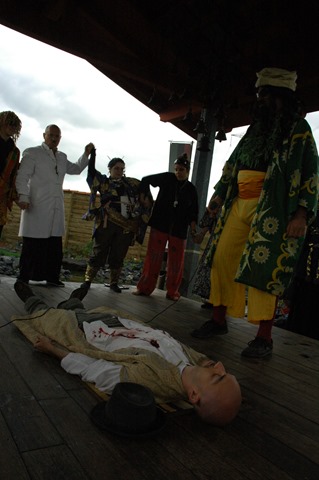
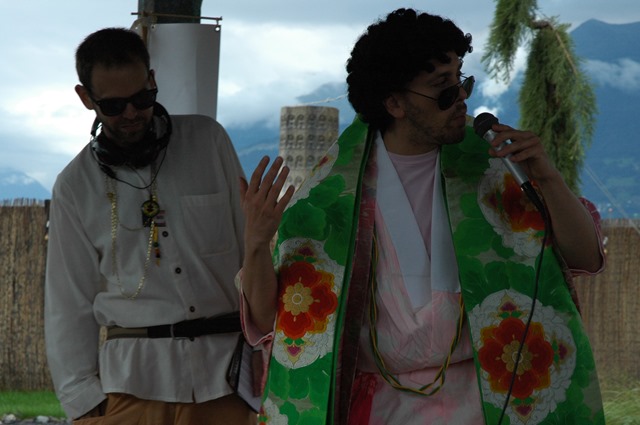
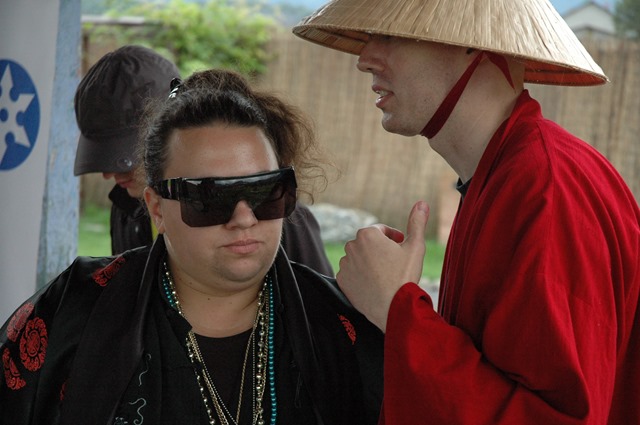
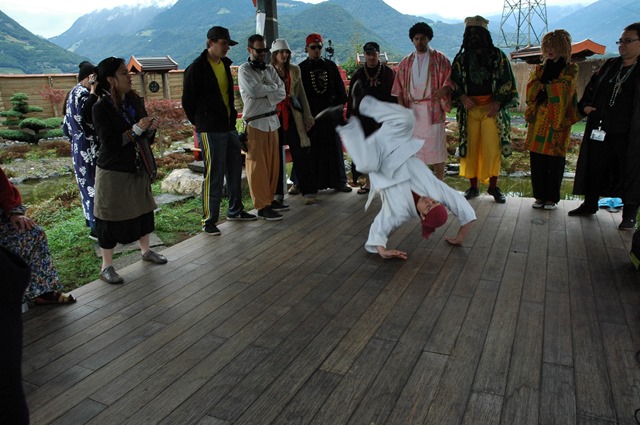
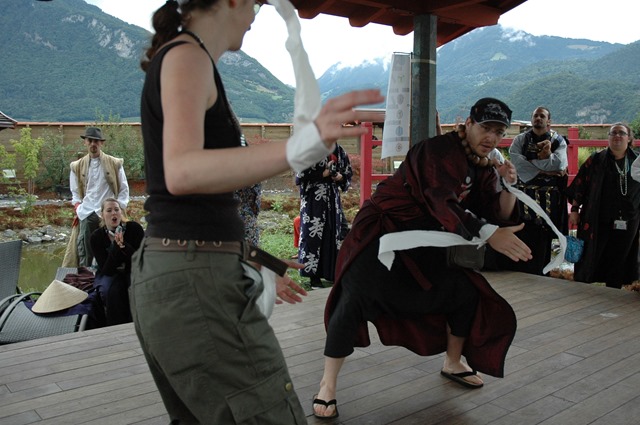

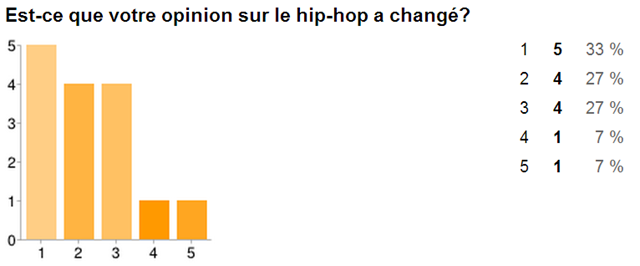

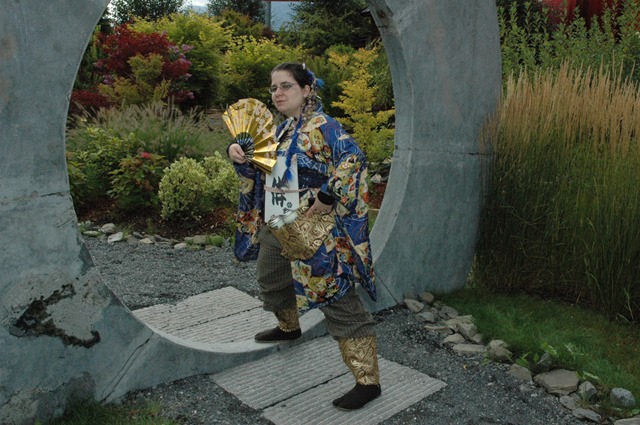
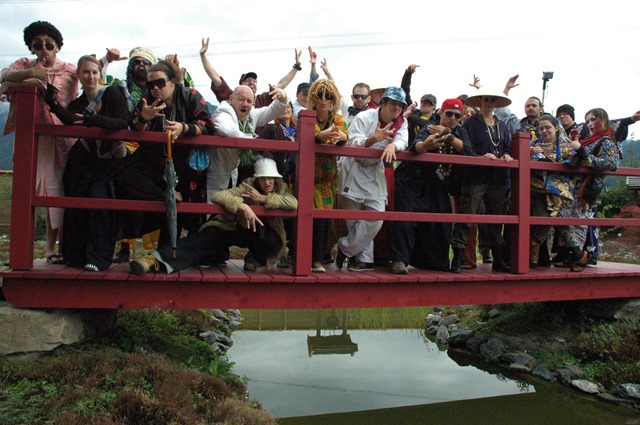



[…] Afroasiatik – a kung-fu hip-hop larp – recap part 1 Afroasiatik – a kung-fu hip-hop larp – recap part 3 […]
[…] were used to build a game world that featured kimono-wearing rappers in a European zen garden Part 3: the performance aspect of the larp and what worked, what […]